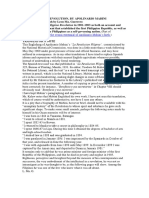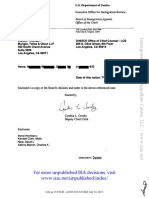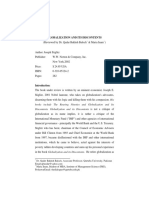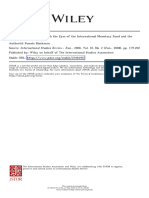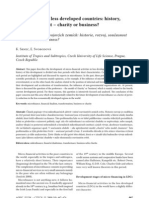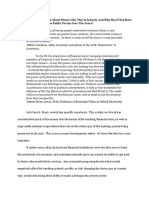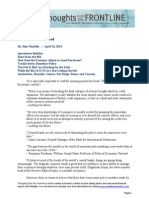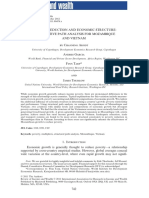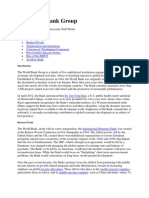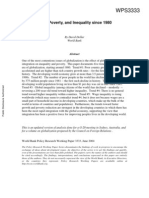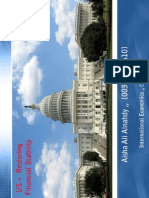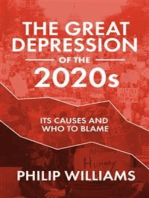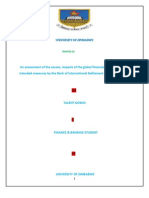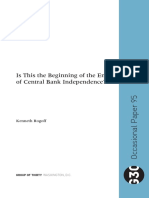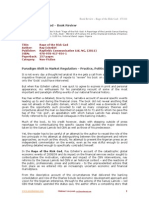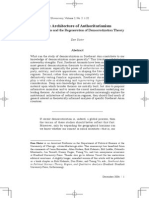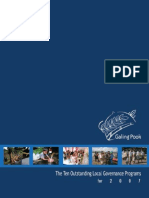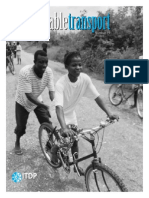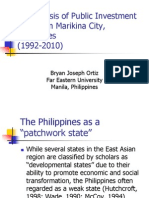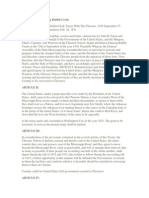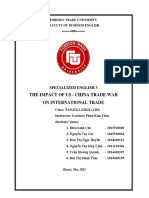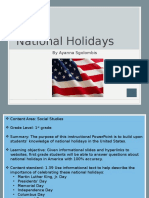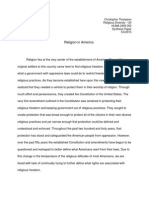Robert Wade On Corruption Poverty
Robert Wade On Corruption Poverty
Uploaded by
bryan001935Copyright:
Available Formats
Robert Wade On Corruption Poverty
Robert Wade On Corruption Poverty
Uploaded by
bryan001935Original Description:
Original Title
Copyright
Available Formats
Share this document
Did you find this document useful?
Is this content inappropriate?
Copyright:
Available Formats
Robert Wade On Corruption Poverty
Robert Wade On Corruption Poverty
Uploaded by
bryan001935Copyright:
Available Formats
http://triplecrisis.
com/poverty-corruption-and-the-changing-world-1950-2050/ POVERTY, CORRUPTION AND THE CHANGING WORLD Robert Wade
On May 29 2013 James Wolfensohn, president of the World Bank from 1995 to 2005, gave the Amartya Sen lecture at the London School of Economics, on the subject, Reflections on a changing world, 19502050. His reflections on the changing world were mainly reflections on what he achieved as World Bank president. He emphasised five.
Re-focusing the World Bank and the whole development community on poverty as the central issue of development. Elevating corruption as a major development problem, instead of sweeping it under the carpet. Writing-down countries debt (especially African) so that World Bank loans no longer went straight out the door to western banks and instead were used for investment in the country. Putting Bank operations in a particular country in the context of a broad vision of the economys future development path five to ten years ahead, in the format of his Comprehensive Development Framework (CDF). Decentralizing World Bank operations, so that more of the total staff operated from regional or country offices rather than from headquarters in Washington DC, and more meetings with shareholding states were held in borrowing countries rather than in Washington or Paris.
Here I comment on the first two: poverty reduction as the central goal of development, and corruption as an explicitly stated problem. I put them in historical context, not least because the World Bank operates without memory of its own history as seen in the fact that most Executive Directors (the civil servants of member countries who constitute the 25 seat Executive Board, which governs the Bank on a day-to-day basis) and also most staff have never even heard of, let alone read any of The World Bank: Its First Half Century, the independently written but semi-official history published by Brookings Institution in 1997. For most of the time since it was published the World Bank book shop has not even stocked it, on the ostensible grounds that the Bank did not publish it. Or to be more exact, these are my findings from asking just about every staff member and Executive Director Ive met since 1997 about the twovolume history, and from enquiring about its availability on every visit to the Bank. I have a vested interest, as author of chapter 13, Greening the Bank: The struggle over the environment, 1970-1995, volume 2, pp.611-734. Poverty reduction and inequality
Wolfensohns elevation of poverty reduction as the central goal echoes then World Bank president Robert McNamara in 1973, forty years ago, who solemnly proposed in a speech in Nairobi, Kenya, a new strategy. The ambitious objective of the new strategy was to eradicate absolute poverty by the end of this century (that is, 2000). He explained that this goal was possible because if courageous decisions are made, then the pace of development can accelerate. In fact much of what Wolfensohn and the Bank said about poverty reduction in 1995-2005 could have been taken almost verbatim from what McNamara said twenty to thirty years before; which raises the obvious question of why the world poverty problem looked as daunting when Wolfensohn re-asserted its importance as when McNamara identified it as the central objective of his new strategy in 1973. But McNamara showed awareness of a closely related issue that remained eclipsed in the Wolfensohn era: income and related inequalities. He said in 1973, despite a decade of unprecedented increase in the gross national product of the developing countries, the poorest segments of their population have received relatively little benefit [because] rapid growth has been accompanied by greater maldistribution of income in many developing countries. He went on to say that the growth of GNP is essentially an index of the welfare of the upper income groups. It is quite insensitive to what happens to the poorest 40%, who collectively receive only 10-15% of the total national income. McNamaras nondescript successors Clausen, Conable, Preston displayed little interest even in poverty reduction, let alone inequality reduction. In 2005, when a group of World Bank staff proposed to write the next World Development Report 2006 on inequality and development, their proposal was rejected by the Executive Board, on grounds that inequality (in contrast to poverty) was inherently a political subject, which the Bank as an apolitical organization should not become involved with. Executive Directors from Russia and China made this argument particularly strongly. And so the group redrafted the proposal to focus not on inequality of outcomes but inequality of opportunities. The Board said, expanding opportunities, thats not political, and gave permission for what became World Development Report 2006: Equity and Development, to be written. The team had to write it in a way which pretended it was all about opportunities, though much of the data and argument was about outcomes. Why this asymmetry of attention? Partly because taking poverty reduction as the central objective makes the elites (at the Bank, in the western development community, in developing countries) feel good about themselves. Whereas taking inequality reduction as a central objective comes uncomfortably close to home, because it raises questions about the legitimacy of the overall structure of income distribution of which elites are prime beneficiaries. Not just the Bank but the whole development community and the whole of the western economics discipline has given far more attention to poverty reduction than to inequality reduction, even as income concentration at the top has soared in the West and in most developing countries since the 1980s. Wolfensohn on 29 May made no mention of inequality as a problem.[1] Statistically, differences between countries in the incidence and severity of poverty are explained much more by differences in average GDP than by differences in the degree of income inequality (as
conventionally measured). But the degree of inequality does affect the magnitude of the effect of growth in GDP on poverty incidence the higher the inequality the smaller the effect of GDP growth on poverty reduction. This is not only from the arithmetical point made by McNamara above that in high inequality countries the growth of GDP is sensitive mainly to the growth of the top decile or two in the income distribution. It is also, more substantively, that the high degrees of inequality typical in developing countries plausibly worsen a whole range of economic, political and social conditions, including through the positive feedback from inequality to social prejudice. Those at the top stereotype those lower down in ways that justify their superior riches, their low taxes, and their decisive influence across broad swathes of public policy, in a positive feedback loop. These issues continue to be remarkably understudied in development economics, including at the World Bank. Corruption On corruption, I begin with my own engagement with the Bank. Having done research on the operation and maintenance of large irrigation canals in India, I was invited to give a seminar about this subject to the India Irrigation Division at the World Bank (in Washington headquarters) in 1981. The India Irrigation Division at that time was lending more than any other division in the whole of the Bank, and it and its division chief enjoyed high prestige. The day before the seminar I conferred with the staff member who organized the seminar, and explained that I was going to show how the engineers operated and maintained the canals in line with the incentives of a well-institutionalized system of bureaucratic corruption (based on auctions for the franchises to particular posts in particular places, at each rank); and that the resulting practices lowered the productivity of canal-irrigated agriculture. The staff member blanched, and implored me not to mention corruption. He said, Michael Cernea *the Banks sole sociologist at that time, dealing with resettlement of people affected by a World Bank project] covers that sort of thing. If you want to talk about corruption, get Michael to organize a seminar in his part of the Bank. Tomorrow we want you to concentrate on the institutional aspects of canal operation. The next day, to the elite staff of the division (predisposed as engineers to be suspicious of a so-called social scientist), I sketched an outline of what I was going to say. Ten minutes into the talk the division chief a hard-charging Israeli irrigation engineer named Gabriel (Gabby) Tibor, held in awe in the whole South Asia region of the Bank because he was reputed to be the only division chief with a direct line to McNamara pushed back his chair, rose to his feet, and stormed out, slamming the door behind him, notwithstanding that he was chairing the meeting. Other senior figures soon followed. The more junior staff who remained, embarrassed, made no comments at the end, though a corpulent Pakistani irrigation chief engineer visiting the division, adorned with gold chain, gold rings and a Rolex, remarked with satisfaction that while the sort of things I described might go on in India he had never heard of such things in Pakistan. [2] Despite this inauspicious start, I worked as a World Bank staff economist from 1984 to 1988. One day in 1986 a British Young Professional (YP) at the Bank rushed into my office (in the Agriculture and Rural Development Department) waving a copy of his newly published World Bank Discussion Paper. He
exclaimed jubilantly that his Discussion Paper was the very first World Bank publication to be allowed to include corruption in the title. In 1986.[3] Fast forward to Wolfensohn on 29 May. He told us that early on in his presidency (which started in 1995) he prepared a draft speech to a major meeting of Bank shareholders, in which he talked about corruption as a major development problem. He sent the draft to the chief legal counsel. The latter soon appeared in his office, saying that he wanted an urgent word with him outside in the foyer. Wolfensohn pointed out that his office was perfectly comfortable, and suggested they sit down and talk there and then. No, said the legal counsel, we must talk outside. Outside in the presumably bug-free foyer the legal counsel whispered to him that he must on no account use the c word. Why?, asked Wolfensohn. Because half of the people you will be speaking to are up to their eyeballs in it, replied the legal counsel, or words to that effect. Wolfensohn went ahead and spoke about corruption, then and throughout his presidency. Earlier in his talk Wolfensohn told us that as a young employee of an American multinational company in 1960 he had gone to newly independent Nigeria to explore business opportunities, and specifically to meet with the chief justice of the Western Region in that connection. While taking photographs in the parliament he was detained by the police and put into a holding cell. Frightened, he asked to make one telephone call. Permission granted, he rang, of course, the chief justice of the Western Region, who promptly secured his released. No hint of corruption in Wolfensohns dealings with the chief justice, apparently. Whereas had a Nigerian businessman the same ready access to the chief justice, then we westerners . These anecdotes make the point that corruption is one of the most misused words in the social science vocabulary misused because treated as inherently bad, as the source of all manner of development problems, while given no analytical boundaries. Its use becomes tautological, almost as elastic as It is gods will. The evaluation of corruption as inherently bad is sustained by stopping the enquiry at the point where corruption takes place, and not continuing to ask what the recipients do with the illegal payments. That reflects the assumption that if private resources go illegally to public officials, the transfer represents a transfer from more productive to less productive uses, the private sector being inherently more productive than the public sector. But the developmental effects must depend on whether the public officials use illegally obtained private resources to invest in enterprises, or childrens education, or to buy higher status in the after-life through temple donations, or to buy their next post. Corruption is normally defined as a violation of public trust. This builds-in the assumption that corruption does not exist in private-private transactions, on grounds that privates are responsible only to their shareholders, not to the public. And corruption is commonly identified with the activities of domestic firms (in developing countries) in their dealings with government. Whereas international (American, European) firms operating in developing countries doing what Wolfensohn did in Nigeria tend to be given a free pass. Here we see the truth of the Swahili proverb, Until the lions have their own historians, the history of hunting will always glorify the hunters. (Thanks to colleague Professor
Ken Shadlen, also at Wolfensohns lecture, for this point about the presumed locus of corruption with domestic firms.) Corruption is often conflated with rent-seeking, and the two concepts certainly overlap. But rent seeking can be perfectly legal; it refers simply to non-directly-productive use of resources aimed at obtaining privileged access to public resources such as the importer who wines and dines the licensing authority, or gives his daughter in marriage to the same. See Anne Kruegers seminal article in the American Economic Review 1974, which purports to show that the private gains from rent seeking are roughly equal to economy-wide losses.[4] But Krueger is a neoliberal economist trying to understand a political economy phenomenon. The cost of corruption is (probably) not mainly its direct effects on resource allocation to non-productive ends, but its swamping of normal incentives to economic and political action. As Michael Lipton says (personal communication), corruption corrupts, and in the same process empowers. Much the same applies to inequality. As suggested earlier, higher inequality reduces the effect of growth on poverty not mainly by the arithmetic translation of growth into poverty reduction, but by creating and sustaining economic and power structures in which the poor have few income opportunities and few competitors for their political support. Corruption helps to perpetuate these economic and power structures. The rise of the Rest Wolfensohn ended by emphasising the shift in economic weight in the world economy. For decades before 2000 the West plus Japan (the old OECD) had around 80% of world GDP for less than 20% of the worlds population; the rest of the world had around 20% of world GDP for more than 80% of the worlds population. By 2050 the West plus Japan will have about 35% of world GDP, and the rest will have 65%. The future of many of you he told his very international audience lies out there in the Rest, and you better get used to it. To illustrate the western resistance to the idea of the inevitability of radical shifts of wealth and power away from the West, Wolfensohn told of a G8 meeting in France in 2003. The G8 graciously invited the presidents of several big developing countries to address them for not more than 12 minutes each. President Lula of Brazil proposed to them that they hold the next G8 meeting in Brazil, because pretty soon three or four of the existing G8 would no longer be at the top table and their seats would be taken by some of the presidents now addressing them, or their successors, and so the surviving members of the G8 better get used to travelling into the developing world for their get-togethers. Lula said it as a kind of joke, but several of the G8 heads of government did not laugh. Wolfensohns confidence in his figures for the rise of the Rest reminded me of J. K. Galbraiths dictum, Astrology was invented in order to make economic forecasting look good. Serious analysts in the 1950s to the 1970s forecast that the Soviet Union would overtake the US in average income by 2000. The rise of the Rest is generally presented in statistical terms, as Wolfensohn did. But a distinction should be made between (a) increases in the relative size of GDP and GDP per capita in some populous developing countries, and (b) a different balance of power between capital, labor and other social
interests in those rising developing countries. If the rising powers bring the same political economy balance as in the West heavily tipped towards capital, especially financial capital then their ascent to global political influence will bring less change to the structure and functioning of the world economy than if they bring a different political economy balance into international circles. So one has to scrutinize China, Brazil, India, Russia, South Africa and some others to find signs of an existing or emerging difference in class balance from the West. Likewise, one has to scrutinize the faltering center of the world economy for signs that it itself is undergoing changes in class configuration as it falters. Economics as a discipline has virtually nothing to say about such structural changes. Governance of the World Bank Wolfensohn said little about the present-day Bank. I asked him in the Q & A what he would say now to borrowing country and non-borrowing country governments, if he were still president, about how they might break the American monopoly of the presidency ever since 1945. I had in mind the appointment of the current president Jim Yong Kim, an American citizen, over the heads of two candidates from developing countries who were almost everywhere including in European governments considered much better qualified than Kim. Behind my question lay my argument that however much the member states of the World Bank chorus that the selection of the president should have no nationality restriction the American monopoly will endure as long as: (1) the US government retains its veto over certain kinds of decisions in the Bank (the only government to have a veto); (2)the West and East Europeans together wish to keep the European monopoly on the ManagingDirectorship of the IMF (and so support whoever the Americans nominate for the World Bank, knowing that the Americans will reciprocate); (3) the Banks high income (non-borrowing) countries maintain a majority of the votes. Even after the arduously negotiated voice reforms of 2008-2010 the high income countries keep a large majority their share fell from the pre-reform 65.3% to the post reform 61.6%.[5]
[1] See further, Robert Wade, Why has income inequality remained on the sidelines of public policy for so long?, Challenge, 55, 3, May-June, 2012, 21-50. [2] I published my analysis of the corruption system which operated in other government departments too and not just the Irrigation Department in The system of political and administrative corruption: Canal irrigation in South India, Journal of Development Studies, 18(3), 1982, 287-328; reprinted in Development Studies Revisited: Twenty Five Years of the Journal of Development Studies, (eds.) Charles Cooper and E.V.K. FitzGerald, Frank Cass: London, 1989 (one of 19 papers selected from 700 papers published by JDS in the first 25 years); and The market for public office: Why the Indian state is not better at development,World Development, 13(4), 1985, 467-497. Reprinted in Corruption, Development, and Inequality: Soft Touch or Hard Graft?, (ed.) Peter Ward, London: Routledge, 1989
[3] Richard Jolly, former director of the Institute of Development Studies (IDS) at Sussex University relates (personal communication) that in 1975 an IDS Fellow, Bernard Schaffer, proposed to run a study seminar on corruption. (IDS study seminars normally lasted several weeks, and brought participants from around the developing world.) The permanent secretary at the Overseas Development Agency (the UK aid agency) rejected the idea, telling the IDS decision-making body that corruption isnt a subject. So someone was dispatched to the library and returned with five books on the topic. Well, even if it is an academic subject, it would be an embarrassing one, replied the permanent secretary. Schaffer persisted, pointing out that Nigeria had recently set up a commission on corruption. The permanent secretary announced, flatly, Well, ODA still wont support a study seminar on the subject. IDS went ahead and funded the study seminar out of reserves. [4] Anne Krueger, The political economy of the rent-seeking society, American Economic Review, 64, 3, 1974: 291-303. [5] Vestergaard, J. and Wade, R. (2013). Protecting power: How Western states retain their dominant voice in the World Banks governance reforms. World Development, http://dx.doi.org/10.1016/j.worlddev.2013.01.031. Also, Jakob Vestergaard and Robert Wade, 2012, Establishing a new Global Economic Council: governance reform at the G20, the IMF and the World Bank, Global Policy, 3, 3, September, 57-69. Robert Wade, 2013, The art of power maintenance: how western states keep the lead in global organizations, Challenge, 56, 1, JanuaryFebruary, 5-39. Robert Wade, 2013 (forthcoming), Protecting power: western states in global organizations, David Held and Charles Roger (eds), Global Governance At Risk, Cambridge: Polity. - See more at: http://triplecrisis.com/poverty-corruption-and-the-changing-world-19502050/#sthash.Irvp1kag.dpuf
The Island Dispute Between China and Japan http://triplecrisis.com/the-island-dispute-between-china-and-japan-the-other-side-of-the-story/
The current dispute between China and Japan over a few barren islands inhabited by goats called Diaoyu in Chinese and Senkaku in Japanese looks at first sight to be a mere territorial spat. But it has escalated to a very dangerous level in recent months first words, then actions of police forces, now actions of air forces, and, behind all these, both sides have mobilised all their military, political, economic, diplomatic, and cultural energies to engage in the dispute. It is more fundamental than normal territorial disputes, because the very identities of the two countries are at stake. A strong narrative has taken hold in the West and much of East Asia about Chinas behaviour, which starts with the proposition that China is the provocateur. Examples include, China sows new seeds of conflict with neighbours;[1] China has adopted an increasingly sharp-elbowed approach to its neighbors, especially Japan;[2] Chinahas launched a new campaign of attrition against Japan over the Senkaku islands. Beijing has sought to challenge Japans decades-old control, despite the risk that an accident could spiral out of control.[3] Proposition two is that Chinas more sharp-elbowed approach is driven by the governments wish to divert public attention from Chinas internal problems, notably slowing economic growth; not by actions of other states. Proposition three is that Chinas bold, brash, and brazen behaviour has prompted the United States recent high-profile pivot to Asia as it winds down wars in West and Central Asia. In the words of an International Herald Tribune report, the United States forges ahead with efforts to counter Chinas influence in Asia, now welcomed in by previously more ambivalent allies. In both Japan and South Korea, the perception of China has changed to being a threat and that has made the U.S. seem much more favourable as a source of security.[4] The allies are also expanding security ties with each other as a way to offset Chinas growing presence. But analysts say Japan will need to reverse a decline in military spending before Washington is convinced Tokyo is doing enough to keep Chinas aspirations in check.[5] We should be suspicious of a narrative that presents the US and Chinas neighbors as innocent victims of Chinas bullying. By presenting the US pivot to Asia as a response to the invitation from Asian countries worried by China, it obscures the US strategy of re-asserting hegemony over East Asia; it too easily elevates China in place of the Soviet Union as the looming external threat to peace-loving democracies, helping the leaders of those democracies to boost their internal support; and it too easily justifies a military build-up all around China, to the benefit of militaries everywhere. Claims and Counter-claims of Sovereignty The islands lie 120 nautical miles northeast of Taiwan, 200 nautical miles east of the Chinese mainland, and 200 miles southwest of the Japanese-controlled island of Okinawa.
Japan formally annexed the islands in 1895, claiming they were not in anybodys ownership or effective control. The Chinese government rejects the annexation as illegitimate. It claims that it had possession of the islands for 500 years before 1895, as charted on Chinese maps and recorded in Chinese ships logs. More specifically, records of Chinese tributary-system missions to ordain the kings of the Ryukyu kingdom (covering islands in the chain from southwest Japan to northeast Taiwan, of which Okinawa is the largest) state that the Diaoyu/Senkaku are on the Chinese side of the boundary between the two entities. China says that the Imperial Japanese military seized the islands in its defeat of the Chinese military in the first Sino-Japanese war of 1894-5. Hence the islands should be returned to China (with ambiguity as to the government of the mainland or the government of Taiwan) as part of the post-1945 return of territories seized by Imperial Japan. Japan counter-claims that the fact that Chinese maps presented the islands as Chinese and that Chinese ships visited gave no legal basis for ownership. The only other basis for ownership, other than annexation, is to have people there, which China did not. So Japans annexation in 1895 is determining. Furthermore, for the first 75 years of Japans control, from 1890 to the late 1960s (when evidence came to hand of undersea oil deposits nearby), China made no complaints about Japanese control. Until 2010 the two governments left the settlement of their mutually exclusive claims undefined. This was the agreement that came out of the diplomatic recognition and friendship talks between the government of Japan and Zhou Enlai in 1972 and again Deng Xiaoping in 1978, who famously suggested that contentious issues like Senkaku should be left to the wiser heads of later generations. However, the government of Japan denies that there ever was such an agreement, and the Japanese governments official records of Premier Tanakas normalisation talks with Zhou Enlai in 1972 do not mention it. The China side replies that the memoirs of Tanakas personal assistant (who attended the talks) say that the agreement was made, as do accounts of the Chinese representatives. Moreover Japans silence on the issue of sovereignty of the islands for almost twenty years after Dengs announcement of the agreement in his 1978 visit to Japan can be interpreted as an implicit recognition of the agreement. In practice, Japan accepted the islands limbo state and did not try to colonize them, exercising practical control only by shooing away non-Japanese fishing boats. The Current Dispute The current dispute began in 2010 when the Japanese government arrested a Chinese fishing boat in defiance of the Fisheries Agreement not to apply domestic laws to trespassing fishermen, and proposed to put the captain on trial. This provoked an unexpectedly furious Chinese reaction, which stiffened the Japanese governments determination not to appear weak in its dealings with China. Then in 2012 the right-wing nationalist Governor of Tokyo purchased the islands from their nominal owner, a Japanese citizen, and proposed to colonize them on his own behalf. To undercut him the government nationalized them bought them as property of the Japanese state; in effect, asserted Japanese sovereignty. In
Chinas eyes, this broke the later, wiser heads agreement, and provoked widespread anti-Japanese riots, anti-Japanese consumer strikes, and suspension of diplomatic relations. The government of China felt compelled to assert its claims to sovereignty, or face humiliation in the eyes of its own public. But much more than humiliation is at stake. China wants to wrestle sovereignty back, or at least restore the status quo ante of undefined sovereignty, for both military and economic reasons. It values the islands for their location in the first island chain, a string of islands south of Japan including Taiwan and smaller ones controlled by Vietnam and the Philippines. This first island chain currently prevents Chinas ballistic submarine fleet from having unobserved access to the Pacific Ocean. If China controlled the Diaoyu/Senkaku, or if no-one did, that would give China a break in the chain. The islands also have value as a platform for radar and missiles in the event of a war between China and Japan; and may well be valuable for oil and gas in surrounding seas. The US Pivot to Asia These factors weight all the more on account of the really big recent change in Chinas external environment: the USs high-profile pivot from Europe and West and Central Asia to East Asia. The shift is open-ended, with no specification of what it means beyond containing China and boosting military alliances with Chinas neighbors. It resumes the emerging strategy of the early years of the President George Bush Jnr years, when the US identified China as a strategic rival. But after 9/11 the US became pre-occupied with Central and West Asia and needed Chinas help in the war on terror. The US diversion allowed China 10 more years of Dengs strategy of building strength in a hidden way, avoiding confrontations. In his first term, when the US was still mired in West Asia and Afghanistan, Obama tried to enlist China as junior partner in a G2, only to be rebuffed. As the US began to withdraw from West and Central Asia and wind down the war on terror, it elevated China as the new threat to world peace. Hence Obamas first overseas trip after re-election was to Myanmar, Thailand and Cambodia, after which he announced that they were potential military allies, as though in expectation of another war. Secretary of State Hilary Clinton also made a long swing through East and Southeast Asia; and senior US defence officials have done the same. None has visited China, at least not publicly. The US administration also announced the deployment of naval forces closer to China the 7th Fleet in the West Pacific and the 5th Fleet to the south of China; stationing of Marines in Australia; and opening of new drone bases in several Southeast Asian locations. (Imagine if China announced military alliances with Cuba, Venezuela, Mexico, Costa Rica.) All this looks like a US-led strategy to contain the rise of China, in Chinese eyes. What is more, the noose being constructed around it is not just military. The Trans Pacific Partnership (TPP) now under negotiation includes a long list of states on both sides of the Pacific: the US, Canada, Mexico, Peru, Chile, Australian, New Zealand, Malaysia, Singapore, Brunei, Vietnam; with Japan, South Korea, Taiwan, Philippines, Laos, Colombia and Costa Rica as potential members. The key feature is that the US is included and China is excluded. Among the TPPs membership criteria, countries must commit to free
trade, and commit to dismantle sizable state-owned enterprises. The latter condition is tailor-made to justify Chinas continued exclusion. Japanese Politics US subordinate allies, especially Japan, see the USs return to Asia as a golden opportunity, maybe the last one, to assert their territorial claims vis--vis China. In Japan, some also see it as an opportunity to strengthen the Japan-US military relationship; for which purpose provoking China to hostile statements and actions is useful for securing public support for closer ties to the US, which could not otherwise be taken for granted. There has been a perennial conflict in the Japanese political and bureaucratic class between the submissive to America group and the independent foreign policy group; a conflict recently heightened by the success of the political party led by Shintaro Ishihara, which rails against what it sees as the Japanese nations servility to the US. However, both those who want closer US ties and those on the nationalist Right who do not, agree on the need to change the nations postwar Constitution to allow Japans military to undertake more than purely defensive combat; and therefore to increase military expenditure. The US is encouraging the government to increase its military spending, much of which would presumably be spent on US weapons systems. Chinese strategists interpret Japans recent actions with respect to the Diaoyu/Senkaku islands as a move useful for both the submissive to America and the independent foreign policy groups. By breaking the pre-condition (sovereignty left undefined), the Japanese government provoked China to assert its claims, which could be presented to the Japanese public and the world as aggression and made to justify both higher military spending and closer US ties. Chinas Humiliation in the Postwar Settlement But Chinas claims rest not only on the location and history of engagement with these particular rocks. They also rest on much further-reaching understanding of Chinas engagement with the West since the Second World War, and the need to reassert a status which the West has consistently denied it. The core of the issue is the contradiction in Chinese eyes between the two treaties settling the Second World War in the East, the Potsdam Declaration and the Treaty of Peace with Japan, generally known as the Treaty of San Francisco. The Potsdam Declaration (Declaration Defining Terms for Japanese Surrender) of 1945 set the terms of Japans unconditional surrender. It was issued jointly by the Allied powers the US, Britain, and China (the Nationalist or Kuomintang government); and the Soviet Union later adhered to the declaration. The Japanese government explicitly accepted it. The declaration said that Japan should retain no overseas territories. A later conference issued the Treaty of San Francisco in 1951, to mark the final settlement of the war in East Asia and the official end of the Allied (American) Occupation of Japan. The US excluded China from the conference, which by then was governed by the Chinese Communist Party. (The US also excluded the Nationalist government, then resident in Taiwan but still claiming to rule the mainland.) The treaty
allocated to Japan hundreds of islands south of Japan, comprising the whole of Okinawa prefecture, including the Senkaku. In Chinas eyes the Treaty of San Francisco and its restoration of offshore islands to Japan is invalid, because (1) it broke the Potsdam Declaration the foundation of the post-war order in East Asia and (2) it resulted from a negotiation in which the government of China (one of the four Allied Powers) was not represented. None of the overseas territories seized by Imperial Japan, including the Senkaku, should have been restored to Japan. In practice the US continued to administer the whole Okinawa island chain until it agreed to restore them to Japans control, in 1972. But neither in the Treaty nor subsequently did the US define the sovereignty of the Senkaku, leaving that to be decided later. However, at the time of the Treaty of San Francisco the US said rather vaguely that the US-Japan security treaty would cover the islands, implying that the US would come to their defence. Recently, with its pivot to Asia, the US clarified that the US-Japan treaty does cover the islands, which China interprets as a provocative move. In short, China sees the Diaoyu/Senkaku dispute through the lens of a long pattern of Japan and the US breaking agreements, to Chinas detriment; including the Treaty of San Francisco breaking the Potsdam Declaration, the Japanese governments 2010 arrest of a Chinese fishing boat in defiance of the Fisheries Agreement, and the Japanese governments 2012 unilateral claim to sovereignty over the islands, breaking the Tanaka-Zhou agreement of 1972. In a civilized world both parties would agree to submit their claims to the International Court of Justice; but neither side is willing to consider such a move. Meanwhile, wisdom on the Chinese side lies in recognizing the truth of Joseph Nyes point, Unless China is able to attract allies by successfully developing its soft power, the rise in its hard military and economic power is likely to frighten its neighbors, who will coalesce to balance its power.[6] But political leaders and the media in the US and Japan also have a responsibility to act on Nyes other point, We should ensure that China doesnt feel encircled or endangered. They are conspicuously failing in this respect. Robert H. Wade is professor of political economy at the London School of Economics - See more at: http://triplecrisis.com/the-island-dispute-between-china-and-japan-the-other-side-ofthe-story/#sthash.JE635TyF.dpuf Triple Crisis Welcomes Your Comments. Please Share Your Thoughts Below.
[1] Intelligence.Unit@mi2g.com, 24 November 2012 [2] Martin Fackler, U.S. plans complicated by allies with uneasy ties, International Herald Tribune, 2223 Dec 2012, p.1 and 4.
[3] Brahma Chellaney, 2012, East Asias defining moment, International Herald Tribune, 22-23 December, p.8. [4] Martin Fackler, 2012, p.4. [5] Martin Fackler, 2012, p.4 [6] Joseph Nye, Dont try to contain China, International Herald Tribune, 28 January 2013, p.9. - See more at: http://triplecrisis.com/the-island-dispute-between-china-and-japan-the-other-side-ofthe-story/#sthash.JE635TyF.dpuf
Misleading Measure of Income and Wealth Inequality: the standard Gini coefficient
It is by now generally accepted that the sharp rise in income and wealth inequality in the US and much of Western Europe over the 1990s and 2000s was one of the bulldozer forces behind the rise in financial fragility. And it has long been accepted that the Gini coefficient is the workhorse measure of inequality. But it is not generally recognized that the coefficient is normally defined in a way which biases the measure in a downward direction, making inequality seem less large than another version of the coefficient would suggest. By this alternative measure inequality is much higher than is generally thought. The standard measure is misleading us into thinking that economic growth is more inclusive than it is. Recall that the Gini coefficient is a number between zero and one that measures the degree of inequality in the distribution of income in a given society (named after an Italian statistician, Corrado Gini). The coefficient is zero for a society in which each member receives exactly the same income; it reaches its maximum value (bounded from above by 1.0) for a society in which one member receives all the income and the rest nothing. As normally defined the Gini says that inequality remains constantgrowth remains inclusiveif all individuals (or countries by average income) experience the same rate of growth, and rises only when upper incomes grow faster than lower incomes. So inequality remains constant if a two person (or two country) distribution x = (10, 40) becomes y = (20, 80). Yet the income gap has grown from 10 to 40. It is at least as plausible to say that inequality remains constantgrowth remains inclusivewhen all individuals (countries) experience the same absolute addition to their incomes; say from x = (10, 40) to y* = (20, 50). If upper income individuals (countries) experience bigger absolute additions, inequality increases, and growth is not inclusive. The normal Gini could be called the Relative Gini. The Gini based on absolute changes could be called the Absolute Ginidefined as the Relative Gini multiplied by the mean income. In the above illustration, the Relative Gini for both distributions is the same, at 0.3. But as mean income doubles from 25 to 50 in the transition from x to y, the Absolute Gini doubles, from 7.5 to 15.0. The Absolute Gini typically rises much more frequently and by much more than than the Relative Gini, and its use would make income inequality into a more salient political issue. For obvious reasons, the Relative Gini could be called a rightist measure, and the Absolute Gini a leftist measure (Kolm 1976a and 1976b). Economists long-standing nonchalance about income inequality is reflected in the fact that the Absolute Gini is rarely used in empirical work. Its unpopularity also reflects the fact that cross-country comparisons of the Absolute Gini are more complicated than for the Relative Gini, because the former depends on the mean of each distribution. This requires that we convert incomes into the same currency (for example, to compare absolute inequality in India with that in the US we have to convert
the two means and income distributions either into rupees or into dollars). And to perform comparisons across time we also need to correct for inflation. The choice of appropriate exchange rates and price deflators becomes crucial for making reliable comparisons of absolute inequality. These inconveniences have often been held up as justification for sticking with relative measures of inequality. But as Kolm explains, these problems are exactly the same ones which are traditionally encountered in the comparisons of national or per capita incomesand they can be given the same traditional solutions. Anyway, convenience could not be an alibi for endorsing injustice (1976a: 419 20). The bottom line isall these technical complexities asidethat students of inequality should not ignore trends in absolute income gaps when making inequality comparisons, as most of the literature does. Thanks to S. Subramanian, Madras Institute of Development Studies, for help on the Absolute Gini. - See more at: http://triplecrisis.com/our-misleading-measure-of-income-and-wealth-inequality-thestandard-gini-coefficient/#sthash.6RavYUef.dpuf
http://triplecrisis.com/the-west-must-allow-a-power-shift-in-international-organizations/#more-9028 The West must Allow Power shifts in international organizations Jakob Vestergaard and Robert H. Wade, Guest Bloggers More than three years after the International Monetary Fund (IMF)s governing body agreed to reform the organizations governance so as to better reflect the increasing economic weight of dynamic emerging market economies in the world economy, only microscopic changes have been made. Emerging market and developing countries (EMDCs) have become increasingly frustrated with Western states as the latter have clinged to their inherited power in the IMF and other important international economic governance organizations. The emerging cooperation among the BRICS (Brazil, Russia, India, China, South Africa)as seen in the advanced-stage negotiations to establish a Development Bank and a Contingent Reserve Arrangementsends a wakeup and smell the coffee message. The West will carry a heavy responsibility for eroding global multilateral governance if it continues to drag its heels on the needed adjustments. Part 1 of a two-part series. Overview of the Current Stalemate Everyone agrees, in principle, that the global governance organizations established after the Second World Warnotably the IMF and the World Bankmust adapt their governance to the fact of a now more multipolar world. Everyone agrees, in principle, that member countries share of votes in the governing boards should reflect their present-day relative economic weight. At first glance the IMF has already taken a big step towards raising the voting power of emerging market and developing countries (EMDCs). In 2010, its member countries agreed both to boost the lending power of the IMFand to shift 6.2% of quota shares, and hence voting power, in favour of dynamic EMDCs. In March 2010, then-Managing Director Dominique Strauss-Kahn hailed this agreement as the most fundamental governance overhaul in the IMFs 65-year history and the biggestever shift of influence in favor of emerging market and developing countries. However, more than three years later the shift has yet to be implemented, largely because the U.S. Congress has still not approved what the countrys executive branch agreed to (it remains an open question, though, whether the executive branch is using the Congress as an excuse for its own unwillingness to act). Moreover, the key shift from developed countries to EMDCs is only 2.6%, the rest being shifts within the category of emerging market and developing countries from over-represented EMDCs to underrepresented EMDCs. Such a small change comes nowhere close to aligning share of votes with any plausible measure of economic weight. If economic weight is measured by gross domestic product (GDP), then the agreed 2010 reforms will still leave very large discrepancies between share of economic weight and share of voting power. Voting
power-to-GDP ratios vary five-fold, from 0.45 in the case of China to 2.15 for Belgium. India (0.6) and Brazil (0.7) remain at the underrepresented end, while the larger European countries remain at the over-represented end. On average, a dollar of EU4 (France, Germany, Italy, and UK) GDP is worth more than twice as big a share of votes as a dollar of GDP from the BRICs. This means that the aggregate voting power of the EU4 is higher (17.6 %) than the aggregate voting power of the BRICs (10.3 %), despite the fact that the GDP of the BRICs, as a share of world GDP, is almost twice as large (24.5 %) as the GDP of the EU4 (13.4 %). However, while most member states agree that, in the interests of simplicity and consistency, economic weight should be measured by GDP, the Europeans are adamant that economic weight is not just GDP but also openness. Intra-Europe trade boosts Europes weight, while intra-U.S. or intra-China trade does not boost the weights of those countries. The BRICS argue that if measures beyond GDP are to be included in the determination of quota (and vote) shares, criteria of contributions to global growth should be among them. The result is stalemate on the commitment made in 2010 to revise the quota formula in time for the next reallocation of quotas. The deadline for a new formula has been postponed several times, and the next deadline, in January 2014, will probably also be postponed. In fact, the quota formula negotiations have been put on hold until the U.S. Congress approves the 2010 reforms. Given the current paralysis in Congress it would be unwise to hold ones breath in anticipation of the new formula. So not only has the 2010 quota share reallocationmodest as it isyet to take effect, but the IMF is continuing forward without a legitimate quota formula , despite repeated affirmations that a new formula must be agreed. Lack of agreement suits the Europeans well, for it protects their current overrepresentation. With this overview in mind, we will now elaborate on the discussion, even at the cost of some repetition of what has just been said. The 2010 quota reforms The voice reforms agreed in 2010 formed part of a larger post-2008-crisis compromise among representatives of the worlds largest economies. The G20 summit in London in 2009 agreed to a tripling of the financial resources of the IMF, including substantial contributions from Japan, China, and a number of other large emerging market economies. This took the form of New Arrangements to Borrow (NAB), which introduced a new funding channel for the IMF to supplement the standard channel of quota subscriptions paid by member states. Unlike quota shares, these additional funds did not give contributing member countries a higher voting share in the Fund. But at the same time as they agreed the NAB, the G20 countries committed themselves to revise the governance of the Fund so as to shift quota share and voting power in favor of dynamic emerging market economies. Their communiqu from the summit in Pittsburgh in September 2009 announced that *w+e are committed to a shift in International Monetary Fund (IMF) quota share to dynamic emerging markets and developing countries of at least 5%.
Given their marching orders by the G20, the Executive Directors set out to negotiate the shift. In 2010 they announced a major success: an agreement to shift6.2 % in quota shares (hence voting power) from overrepresented to underrepresented countries. But this was misleading, to put it politely. Less than half of the mentioned figure is what really matters: a shift of voting power from advanced economies to EMDCs. The G7 countries, as a group, concede only 1.8 percentage points of their voting power, in aggregate. Table 1 presents the voting power of 15 large countries, as it currently stands (December 2013) and as it will be if or when the 2010 voice reforms take effect. As can be seen, most changes are microscopic. For only two out of 15 large countries will the change in voting power be larger than half a percentage point (China, with a 2.26 percentage point increase, and poor Belgium, with a 0.56 percentage point loss). Table 1: Voting power, selected large economies
Note: A selection of 15 of the worlds 30 largest economies, based on a 50/50 GDP blend (i.e. giving 50 % weight to GDP at market prices and 50% weight to GDP in purchasing power parity terms), World Development Indicators 2012 (November). Data for current voting power are July 2013 actual voting shares. - See more at: http://triplecrisis.com/the-west-must-allow-a-power-shift-in-internationalorganizations/#more-9028 Part 2 The IMFs existing quota formula allocates shares to member countries on the basis of four variables (with their weights in the formula given in parentheses):
Size of a members economy, as measured by GDP (50%); Members integration into the world economy, or openness (30 %);
Members potential need for Fund resources, measured in terms of variability of current receipts and net capital flows (15%); and Members financial strength and ability to contribute to the Funds finances, as measured by its foreign exchange reserves (5%).
Instead of announcing a new formula in January 2013, as planned, the Executive Board of Directors (EBD) reported to the Board of Governors on the outcome of the Quota Formula Review (IMF 2013). The main conclusions were: (a) it was agreed that GDP should remain the most important variable, with the largest weight in the formula and scope to further increase its weight; and (b) there was considerable support for dropping variability from the formula (IMF 2013: 2-3). Beyond these, the Executive Directors could agree on little. Then, in October 2013, following the IMFs annual meetings, the council of ministers which steers the IMF (International Monetary and Finance Committee) declared in its communiqu : we urge the Executive Board to agree on a new quota formula *and+ reaffirm that any realignment in quota shares is expected to result in increased shares for dynamic economies in line with their relative positions in the world economy. But again, in the subsequent period from October to December 2013 the Executive Board has made no progress, and will almost certainly postpone the latest deadline to sometime well beyond January 2014. The whole negotiation process has been put on hold until U.S. Congress approves the 2010 reforms. Voting power imbalances remain massive Most member states agree that voting share should be closely linked to GDP share, as the simplest, least unambiguous measure of economic weight. Table 2 shows voting power-to-GDP ratios, both as of today and if and when the changes agreed in 2010 are put into effect. If voting power were aligned with GDP share, we should expect all countries to cluster close to 1.As can be seen, the voting power-to-GDP ratios show a wide dispersion. They vary five-fold, from 0.45 in the case of China to 2.15 for Belgium. Not just China but also India (0.60) and Brazil (0.73) are underrepresented, while the larger European countries are over-represented by this criterion. On average, a dollar of GDP in the EU4 countriesGermany, France, UK and Italyis worth more than twice as much as a dollar of GDP in one of the BRIC countries, in terms of voting power in the Fund. This means that the aggregate voting power of the EU4 is higher (15.6 %) than the aggregate voting power of the BRICs (13.5 %), despite the fact that the GDP of the BRICs, as a share of world GDP, is almost twice as large (24.5 %) as the GDP of the EU4 (13.4 %). Table 2 Voting power-to-GDP ratios, selected large economies
Understanding the quota formula stalemate The problems are not just that the shifts in voting power agreed upon in 2010 have not been implemented, and that even if and when they are implemented they will leave massive voting power imbalances. On top of these is the problem of revising the quota formula that has guided allocations of shares in the IMF for decades. Successive deadlines have come and gone, with next to no agreement, the next one looming in January 2014. At the core of the stalemate is the notion of relative country economic weight. The default position for most countries remains share of world GDP, simply because of its simplicity. But the Europeans insist that economic weight is not just GDP but also openness; integration with the world economy. Not coincidentally, Europes weight is then boosted by intra-Europe trade, while the weights of the United States, China, India, Brazil, et al. are not boosted by their internal trade. With this and related arguments Europeans insist that European countries are in fact underrepresented, not overrepresentedan assertion which provokes much scowling and scoffing from other participants, including the BRICS. Many countries are prepared to accept that openness should have some weight in the new quota formula, but say that the current measure of openness is seriously flawed reflecting both conceptual and methodological issues and must be replaced by a measure that avoids the positive bias for intraEurope trade (IMF 2013: 3).And they go on to say that if openness is included, so should other factors. The BRICS demand a weight for contribution to global economic growth. In response to such galloping complexity, many participants fall back on share of GDP as the only viable criteriononly to encounter outraged European objections. Multilateralism at risk Many representatives from EMDCs, including the BRICS, are getting increasingly fed up with Western determination to cling to power not just in the IMF but also in the World Bank and other important international economic governance organizations. They are plotting how to induce Western states to agree to real reductions in the Western voice. One way is for them to move towards the exit. So they have been signaling that theyespecially the BRICSwill be more careful and selective before agreeing to activate the New Arrangements to Borrow (NAB), in the words of a participant. And the
BRICS are well along in the negotiation of a BRICS Development Bank and a BRICS Contingent [Foreign Exchange] Reserve Arrangement (for currency swaps or pooling), scheduled to be signed at the next BRICS summit in 2014. It is difficult to escape a sense that Western governments are allowing their drive to cling to power to obscure the bigger issues at stake. Western governments must go beyond their rhetorical commitment to shift voting power towards EMDCs, and actually do itfor the sake of boosting the effectiveness of multilateral economic governance and checking the present drive towards coalitions of the willing in plurilateral arrangements, a drive which raises the prospect of a return to the competing power blocs of 18th to 20th century Europe and the chronic instability they generated. Policy recommendations
The IMF should realign quota shares to address long-standing voting power imbalances, notably the overrepresentation of European countries and underrepresentation of emerging market economies. The IMF should agree to a new quota formula that establishes a much closer link (than does the current formula) between relative economic weight in the world economy and voting power in the IMF. To preserve the voting power of the poorest developing countries, the share of basic votes in total votes should be doubled (from 5.5 % to at least 10%), so as to restore them to the same level as when the IMF was founded. The responsibility for taking these steps rests primarily with the Western states, which have benefited from the beginning of the IMF by a series of high hurdles against loss of voice in Fund governance.
Further readings IMF (2010). IMF Quota and Governance Elements of an Agreement. Report of the Executive Board to the Board of Governors. Washington, DC: International Monetary Fund. IMF (2013). Report of the Executive Board of Governors on the Outcome of the Quota Formula Review. Washington, DC: International Monetary Fund. Lesage, D., Debaerre, P., Dierckx, S. and Vermeiren, M. et al (2013). IMF reform after the crisis. International Politics, 50 (4): 553-578. Vestergaard, J. and Wade, R. (2013). Protecting power: How Western states retained their dominant voice in the World Banks governance reforms.World Development, 46: 153-164. - See more at: http://triplecrisis.com/the-west-must-allow-a-power-shift-in-international-organizationspart-2/#more-9039
You might also like
- Lesson 3 Economic Globalization, Poverty, and InequalityDocument13 pagesLesson 3 Economic Globalization, Poverty, and InequalityCarlo Magcamit100% (2)
- THE PHILIPPINE REVOLUTION by Apolinario MabiniDocument30 pagesTHE PHILIPPINE REVOLUTION by Apolinario Mabinibryan001935100% (2)
- Found Footage Film As Discursive Metahistory: Craig Baldwin'sDocument22 pagesFound Footage Film As Discursive Metahistory: Craig Baldwin'sJihoon KimNo ratings yet
- O-S-N-M-, AXXX XXX 633 (BIA July 10, 2017)Document6 pagesO-S-N-M-, AXXX XXX 633 (BIA July 10, 2017)Immigrant & Refugee Appellate Center, LLCNo ratings yet
- The War of 1812Document5 pagesThe War of 1812Yasir Rauf100% (1)
- Poverty and Poverty ReductionDocument2 pagesPoverty and Poverty ReductionAhsan HabibNo ratings yet
- The International Financial Institutions: Chapter SummaryDocument5 pagesThe International Financial Institutions: Chapter SummarySubhash MalewarNo ratings yet
- 7 NOV Blackmon 2008Document24 pages7 NOV Blackmon 2008Ataur Rahman MaruphNo ratings yet
- Global RecessionsDocument74 pagesGlobal RecessionsboyapatisandeepkumarNo ratings yet
- Pacific Affairs, University of British Columbia Pacific AffairsDocument4 pagesPacific Affairs, University of British Columbia Pacific Affairsmonster_newinNo ratings yet
- Foreclosing the Future: The World Bank and the Politics of Environmental DestructionFrom EverandForeclosing the Future: The World Bank and the Politics of Environmental DestructionRating: 5 out of 5 stars5/5 (2)
- Walden Bello 2Document12 pagesWalden Bello 2temujin03No ratings yet
- (M) Book Review GlobalizationDocument15 pages(M) Book Review GlobalizationkirpaNo ratings yet
- Central Bankers at the End of Their Rope?: Monetary Policy and the Coming DepressionFrom EverandCentral Bankers at the End of Their Rope?: Monetary Policy and the Coming DepressionNo ratings yet
- Blackmon RethinkingPovertyEyes 2008Document25 pagesBlackmon RethinkingPovertyEyes 2008salmazeus87No ratings yet
- History of Micro FinanceDocument8 pagesHistory of Micro FinanceAlaji Bah CireNo ratings yet
- EconomistsDocument7 pagesEconomistssubgrewNo ratings yet
- MPRA Paper 33142Document32 pagesMPRA Paper 33142Nikhil BoggarapuNo ratings yet
- The World Bank Is Widely Considered The WorldDocument9 pagesThe World Bank Is Widely Considered The WorldKinetibebNo ratings yet
- Impoverishing A ContinentDocument28 pagesImpoverishing A ContinentAzhan AhmedNo ratings yet
- Global Recessions: CAMA Working Paper 10/2020 February 2020Document74 pagesGlobal Recessions: CAMA Working Paper 10/2020 February 2020vitoria soaresNo ratings yet
- Mauldin July 5Document11 pagesMauldin July 5richardck61No ratings yet
- Ceslav Ciobanu The Global Financial Crisis - EngDocument17 pagesCeslav Ciobanu The Global Financial Crisis - EngAlexandru GribinceaNo ratings yet
- Chapter 1 2 3Document54 pagesChapter 1 2 3chugzNo ratings yet
- Soederberg, S., Zarembka, P. - Neoliberalism in Crisis, Accumulation, and Rosa Luxemburgs Legacy (2004)Document292 pagesSoederberg, S., Zarembka, P. - Neoliberalism in Crisis, Accumulation, and Rosa Luxemburgs Legacy (2004)matic.luka.osNo ratings yet
- Ibdc Paper.Document44 pagesIbdc Paper.musharukwaNo ratings yet
- Mauldin April 26Document16 pagesMauldin April 26richardck61No ratings yet
- Appolinario Gpe Final Research Paper-1Document36 pagesAppolinario Gpe Final Research Paper-1Robert DefiaNo ratings yet
- Arndt, Garcia, Tarp, Thurlow (2012) Poverty Reduction & Economic Structure - Comparative Path Analyis For Mozambique & VietnamDocument23 pagesArndt, Garcia, Tarp, Thurlow (2012) Poverty Reduction & Economic Structure - Comparative Path Analyis For Mozambique & VietnamNajaha GasimNo ratings yet
- International Financial Institutions: Dealing With New Global ChallengesDocument33 pagesInternational Financial Institutions: Dealing With New Global ChallengesRAKESH SHARMANo ratings yet
- A Decade After The Global Recession: Lessons and Challenges For Emerging and Developing EconomiesDocument436 pagesA Decade After The Global Recession: Lessons and Challenges For Emerging and Developing EconomiesramanaraoNo ratings yet
- GDP As A Measure of Economic WelfareDocument12 pagesGDP As A Measure of Economic WelfareАндрей ГоловинNo ratings yet
- What The World Bank Means by Poverty Reduction and Why It MattersDocument25 pagesWhat The World Bank Means by Poverty Reduction and Why It MattersDingo PingoNo ratings yet
- The Challenge of Economic Development: A Survey of Issues and Constraints Facing Developing CountriesFrom EverandThe Challenge of Economic Development: A Survey of Issues and Constraints Facing Developing CountriesNo ratings yet
- The World Bank GroupDocument4 pagesThe World Bank GroupGill Wallace HopeNo ratings yet
- Fault Lines How Hidden Fractures Still Threaten The World EconomyDocument2 pagesFault Lines How Hidden Fractures Still Threaten The World Economyprasenjit_baishyaNo ratings yet
- Beyond Buzzwords: What Is "Inclusive Development"?: Synthesis ReportDocument23 pagesBeyond Buzzwords: What Is "Inclusive Development"?: Synthesis ReportAnonymous 201fQxNo ratings yet
- Jackson Hole Economic SymposiumDocument3 pagesJackson Hole Economic SymposiumCalvin YeohNo ratings yet
- Globalization, Poverty, and Inequality Since 1980: by David Dollar World BankDocument46 pagesGlobalization, Poverty, and Inequality Since 1980: by David Dollar World Bankshreeshlko100% (2)
- Economic-Crisis-In-The-21st-Century (RobertsDocument32 pagesEconomic-Crisis-In-The-21st-Century (RobertsShih-Yu ChouNo ratings yet
- International Economics: Westminster International College, BA (Hons) Business StudiesDocument12 pagesInternational Economics: Westminster International College, BA (Hons) Business StudiesAisha AlnahdyNo ratings yet
- The Contemporary World: GlobalizationDocument20 pagesThe Contemporary World: GlobalizationAna0% (1)
- Risk, Recovery, and Empowerment: The Kazakhstan Bank Restructure Case StudyFrom EverandRisk, Recovery, and Empowerment: The Kazakhstan Bank Restructure Case StudyNo ratings yet
- PEOPLES-HISTORY-IMF-WBDocument49 pagesPEOPLES-HISTORY-IMF-WBMarlon LesterNo ratings yet
- Lesson 2, Topic 1 - The Global EconomyDocument6 pagesLesson 2, Topic 1 - The Global EconomyAirish Joyce BenozaNo ratings yet
- The Great Depression of the 2020s: Its Causes and Who to BlameFrom EverandThe Great Depression of the 2020s: Its Causes and Who to BlameNo ratings yet
- Causes, Effects and The Solutions of The Global Financial Crisis and BIS Reaction.Document27 pagesCauses, Effects and The Solutions of The Global Financial Crisis and BIS Reaction.TALENT GOSHO100% (1)
- What The World Bank Means by Poverty Reduction, and Why It MattersDocument24 pagesWhat The World Bank Means by Poverty Reduction, and Why It MattersPaul CammackNo ratings yet
- Jeron: The World Bank Is An International Financial Institution That Provides Loans and Grants To TheDocument22 pagesJeron: The World Bank Is An International Financial Institution That Provides Loans and Grants To TheKairmela PeriaNo ratings yet
- ADBI News: Volume 1 Number 2 (2007)Document8 pagesADBI News: Volume 1 Number 2 (2007)ADBI PublicationsNo ratings yet
- Position Paper GuideDocument5 pagesPosition Paper GuideCada VerousNo ratings yet
- Chap 8 1drDocument51 pagesChap 8 1drbalutansutraNo ratings yet
- (Historical Materialism Book Series 32) Lapavitsas, Costas - Financialisation in Crisis (2012, Brill Academic Pub)Document276 pages(Historical Materialism Book Series 32) Lapavitsas, Costas - Financialisation in Crisis (2012, Brill Academic Pub)monikaNo ratings yet
- From Good to Bad Bankers: Lessons Learned from a 50-Year Career in BankingFrom EverandFrom Good to Bad Bankers: Lessons Learned from a 50-Year Career in BankingNo ratings yet
- Is This The Beginning of The End of Central Bank Independence?Document40 pagesIs This The Beginning of The End of Central Bank Independence?Anonymous HsoXPyNo ratings yet
- The Promise of Global InstitutionsDocument2 pagesThe Promise of Global InstitutionsfizaAhaider33% (3)
- 4 Global Contexts: Aims of This ChapterDocument21 pages4 Global Contexts: Aims of This ChapterstephjmccNo ratings yet
- A Arquitetura Global Dos Bancos Multilaterais de Desenvolvimento - Um Sistema de Dívida Ou Desenvolvimento.2021, IngDocument47 pagesA Arquitetura Global Dos Bancos Multilaterais de Desenvolvimento - Um Sistema de Dívida Ou Desenvolvimento.2021, IngNeto ViturinoNo ratings yet
- Draft Guide For The PerplexedDocument32 pagesDraft Guide For The Perplexedronald youngNo ratings yet
- Rage of The Risk God - Book ReviewDocument4 pagesRage of The Risk God - Book ReviewProshareNo ratings yet
- Central Bank Capitalism: Monetary Policy in Times of CrisisFrom EverandCentral Bank Capitalism: Monetary Policy in Times of CrisisNo ratings yet
- Monetary Policy and Its Unintended ConsequencesFrom EverandMonetary Policy and Its Unintended ConsequencesRating: 5 out of 5 stars5/5 (1)
- Sweden - Case - Study Transit Cost by NYUDocument52 pagesSweden - Case - Study Transit Cost by NYUbryan001935No ratings yet
- Istanbul A Successful Turnkey SystemDocument5 pagesIstanbul A Successful Turnkey Systembryan001935No ratings yet
- Project-Description - Metro Manila MRT 4Document39 pagesProject-Description - Metro Manila MRT 4bryan001935No ratings yet
- 2016 Imm Transport ReportDocument150 pages2016 Imm Transport Reportbryan001935No ratings yet
- SC CPS05 Notice of Contract Award SGNDocument3 pagesSC CPS05 Notice of Contract Award SGNbryan001935No ratings yet
- Alfred McCoy A Rupture in US-Philippine RelationsDocument5 pagesAlfred McCoy A Rupture in US-Philippine Relationsbryan001935No ratings yet
- TJD Slater PDFDocument22 pagesTJD Slater PDFbryan001935No ratings yet
- 2007 Galing Pook Souvenir ProgramDocument32 pages2007 Galing Pook Souvenir Programbryan001935No ratings yet
- ITDP ST - Magazine 11 PDFDocument32 pagesITDP ST - Magazine 11 PDFbryan001935No ratings yet
- 2012galingpookwinners PDFDocument36 pages2012galingpookwinners PDFbryan001935100% (1)
- 2004 Marikina City State of The City AddressDocument18 pages2004 Marikina City State of The City Addressbryan001935No ratings yet
- Public Investment Policies in Marikina City, PhilippinesDocument25 pagesPublic Investment Policies in Marikina City, Philippinesbryan001935No ratings yet
- 176 BibliographyDocument86 pages176 BibliographySnehal ShahNo ratings yet
- My History EssayDocument2 pagesMy History Essayمهسا جونNo ratings yet
- APUSH CHapter 9 OutlineDocument2 pagesAPUSH CHapter 9 OutlineMorgan FrancisNo ratings yet
- Base Oils in Crisis: Making Sense of Chemical PricesDocument32 pagesBase Oils in Crisis: Making Sense of Chemical PricesAnonymous tIwg2AyNo ratings yet
- Riverside County Board of Supervisors Map FDocument4 pagesRiverside County Board of Supervisors Map FThe Press-Enterprise / pressenterprise.comNo ratings yet
- ADSS PGR Conference Programme 30.5.18Document20 pagesADSS PGR Conference Programme 30.5.18De asiniumbraNo ratings yet
- Treaty of Dancing Rabbit Creek - Pages 1 and 2Document2 pagesTreaty of Dancing Rabbit Creek - Pages 1 and 2nathanle98No ratings yet
- 25 04 2023 (American Imperialism)Document3 pages25 04 2023 (American Imperialism)Pushkar PandeyNo ratings yet
- Commission On Language Learning Americas LanguagesDocument64 pagesCommission On Language Learning Americas Languagescorey_c_mitchell100% (3)
- American TriviaDocument2 pagesAmerican TriviadjelifNo ratings yet
- Tiếng Anh Chuyên NgànhDocument25 pagesTiếng Anh Chuyên NgànhtrungNo ratings yet
- American Atheist Magazine - Q2 2021Document32 pagesAmerican Atheist Magazine - Q2 2021American Atheists, Inc.100% (1)
- Definition of GeopoliticsDocument15 pagesDefinition of GeopoliticsNatala WillzNo ratings yet
- Young Et Al - 2022 - Bus Hor - US Corps Are From MarsDocument13 pagesYoung Et Al - 2022 - Bus Hor - US Corps Are From Marssarah lingNo ratings yet
- MBTA List of Birds Final RuleDocument22 pagesMBTA List of Birds Final RulePatricia DillonNo ratings yet
- Solution Manual - Chapter 1: Study QuestionsDocument4 pagesSolution Manual - Chapter 1: Study QuestionsMariela BelénNo ratings yet
- Instructional PowerpointDocument13 pagesInstructional Powerpointapi-310535182No ratings yet
- Oerlikon - Welding Consumables - Air Liquide Welding - Page N° 13 - PDF Catalogue - Technical Documentation - BrochureDocument45 pagesOerlikon - Welding Consumables - Air Liquide Welding - Page N° 13 - PDF Catalogue - Technical Documentation - BrochuresalomaodomingosNo ratings yet
- A Comparative Study of Federalism in Pakistan After 18thDocument9 pagesA Comparative Study of Federalism in Pakistan After 18thFaizali Faizali45No ratings yet
- Carlos FuentesDocument25 pagesCarlos Fuentessebastian_stratanNo ratings yet
- NAACP's Out of Focus, Out of Sync Take 3: A Report On The Film and Television Industry (November 2003)Document52 pagesNAACP's Out of Focus, Out of Sync Take 3: A Report On The Film and Television Industry (November 2003)Mr Alkebu-lan100% (1)
- PRIYANKA Complete Interview QuestionsDocument12 pagesPRIYANKA Complete Interview QuestionsMOHIT KUMAR WISDOMNo ratings yet
- Bahrain TIP and Water ReportDocument48 pagesBahrain TIP and Water Reportfati159No ratings yet
- Pierson - New Politics Welfare StateDocument38 pagesPierson - New Politics Welfare StateJoseph MathewNo ratings yet
- Cultural Times: The First Global Map of Cultural and Creative IndustriesDocument120 pagesCultural Times: The First Global Map of Cultural and Creative IndustriesFacundo Alvarez100% (1)
- Why I'm Running - Vanguard Press - May 18, 1986Document3 pagesWhy I'm Running - Vanguard Press - May 18, 1986Seven Days VermontNo ratings yet
- Synthesis PaperDocument3 pagesSynthesis Paperapi-252559092No ratings yet

